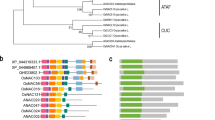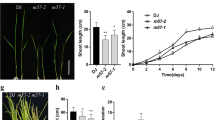Abstract
LecRLKs (lectin receptor-like kinases) is a subfamily of RLKs (receptor like kinase) and takes part in mounds of biological processes in plant-environment interaction. However, the roles of LecRLKs in plant development are still elusive. Here, we showed that OsSRK1, belonging to LecRLK family in rice, had a relative higher expression in internode and stem in comparison with that in root and leaf. Importantly, srk1-1 and srk1-2, two genome-edited mutants of OsSRK1 using CRISPR/Cas9 system, exhibited obviously a decreased plant height and shorter length of the first internode and second internode compared with those in WT. Subsequently, histochemical sectioning showed that the stem diameter and the cell length in stem are significantly reduced in srk1-1 and srk1-2 compared with WT. Moreover, analyzing the expression of four gibberellin biosynthesis related genes showed that CPS, KAO, KS1, and GA3ox2 expression had similar levels between WT and mutants. Importantly, we further verified that OsSRK1 can directly interact with gibberellin receptor GID1. Together, our results revealed that LecRLKs family member OsSRK1 positively regulated plant height by controlling internode elongation which maybe depended on OsSRK1-GID1 interaction mediated gibberellin signaling transduction.





Similar content being viewed by others
References
Desclos-Theveniau M, Arnaud D, Huang TY, Lin JGC, Chen WY, Lin YC, Zimmerli L (2012) The Arabidopsis lectin receptor kinase LecRK-V.5 represses stomatal immunity induced by Pseudomonas syringae pv. tomato DC3000. Plos Pathogens 8(2):e1002513
Gui J, Zheng S, Liu C, Shen JH, Li JM, Li LG (2016) OsREM4.1 interacts with OsSERK1 to coordinate the interlinking between abscisic acid and brassinosteroid signaling in rice. Dev Cell 38(2):201–213
Hu S, Hu X, Hu J, Shang L, Dong G, Zeng D, Guo L, Qian Q, Xiao W (2018) A new rice germplasm for large-scale indoor research. Mol Plant 11(11):1418–1420
Itoh H, Ueguchi-Tanaka M, Sentoku N, Kitano H, Matsuoka M, Kobayashi M (2001) Cloning and functional analysis of two gibberellin 3β-hydroxylase genes that are differently expressed during the growth of rice. Proc Natl Acad Sci 98(15):8909–8914
Jefferson RA, Burgess SM, Hirsh D (1986) beta-Glucuronidase from Escherichia coli as a gene-fusion marker. Proc Natl Acad Sci 83(22):8447–8451
Jiang Y, Bao L, Jeong SY, Kim SK, Zhang Q (2012) XIAO is involved in the control of organ size by contributing to the regulation of signaling and homeostasis of brassinosteroids and cell cycling in rice. Plant J Cell Mol Biol 71(3):398–408
Li YX, Tang DY, Li L, Zhao XY, Lin JZ, Liu XM (2018) Plant Stature Related receptor-like Kinanse2 (PSRK2) acts as a factor that determines stem elongation toward gibberellins response in rice. Biosci Biotechnol Biochem 82(11):1931–1941
Liu Y, Xu Y, Xiao J, Ma Q, Dan L, Zhen X, Kang C (2011) OsDOG, a gibberellin-induced A20/AN1 zinc-finger protein, negatively regulates gibberellin-mediated cell elongation in rice. J Plant Physiol 168(10):1100–1105
Ohta S, Mita S, Hattori T, Nakamura K (1990) Construction and expression in tobacco of a b-glucuronidase (GUS) reporter gene containing an intron within coding sequence. Plant Cell Physiol 31(6):805–813
Sasaki A, Ashikari M, Ueguchi-Tanaka M, Itoh H, Nishimura A, Swapan D, Ishiyama K, Saito T, Kobayashi M, Khush GS (2002) Green revolution: a mutant gibberellin-synthesis gene in rice. Nature 416(6882):701–702
Sun YL, Qiao ZZ, Muchero W, Chen JG (2020) Lectin receptor-like kinases: the sensor and mediator at the plant cell surface. Front Plant Sci 11:596301
Tong H, Xiao Y, Liu D, Gao S, Liu L, Jin Y, Qian Q, Chu C (2014) Brassinosteroid regulates cell elongation by modulating gibberellin metabolism in rice. Plant Cell 26(11):4376
Ueguchi-Tanaka M, Ashikari M, Nakajima M, Itoh H, Katoh E, Kobayashi M, Chow TY, Hsing YC, Kitano H, Yamaguchi I, Matsuoka M (2005) GIBBERELLIN INSENSITIVE DWARF1 encodes a soluble receptor for gibberellin. Nature 437:693–698
Wang J, Hu T, Wang W, Hu H, Wei Q, Bao C (2019) Investigation of evolutionary and expressional relationships in the function of the leucine-rich repeat receptor-like protein kinase gene family (LRR-RLK) in the radish (Raphanus sativus L.). Sci Rep 9:6937
Wang YH, Li JY (2008) Molecular basis of plant architecture. Annu Rev Plant Biol 59:253–279
Xue Q, Liu JH, Zhao WS, Chen X, Peng Y (2013) Gibberellin 20-oxidase gene regulates plant stature and disease development in rice. Mol Plant Microbe Interact 26(2):227–239
Yamamuro C, Ihara Y, Xiong W, Noguchi T, Fujioka S, Takatsuto S, Ashikari M, Matsuoka KM (2000) Loss of function of a rice brassinosteroid insensitive1 homolog prevents internode elongation and bending of the lamina joint. Plant Cell 12(9):1591–1605
Ye H, Feng J, Zhang L, Zhang J, Mispan MS, Cao Z, Yang J, Beighley DH, Gu X (2015) Map-based cloning of qSD1-2 identified a gibberellin synthesis gene regulating the development of endosperm-imposed dormancy in rice. Plant Physiol 169(3):2152–2165
Yu F, Shi J, Zhou JY, Gu JN, Chen QH, Li J, Cheng W, Mao DD, Tian LF, Buchanan BB, Li LG, Chen LB, Li DP, Luan S (2010) ANK6, a mitochondrial ankyrin repeat protein, is required for male-female gamete recognition in Arabidopsis thaliana. Proc Natl Acad Sci 107(51):22332–22337
Zhang Y, Callaway EM, Jones JB, Wilson M (2009) Visualisation of hrp gene expression in xanthomonas euvesicatoria in the tomato phyllosphere. Eur J Plant Pathol 124(3):379–390
Zhang H, Liang WQ, Yang XJ, Luo X, Jiang N, Ma H, Zhang DB (2010) Carbon starved anther encodes a MYB domain protein that regulates sugar partitioning required for rice pollen development. Plant Cell 22:672–689
Zhang H, Zhang JS, Wei PL, Zhang BT, Gou F, Feng ZY, Mao YF, Yang L, Zhang H, Xu NF, Zhu JK (2014) The CRISPR/Cas9 system produces specific and homozygous targeted gene editing in rice in one generation. Plant Biotechnol J 12:797–807
Zhang BW, Wang XL, Zhao ZY, Wang RJ, Huang XH (2015) OsBRI1 Activates BR signaling by preventing binding between the TPR and kinase domains of OsBSK3 via phosphorylation 1. Plant Physiol 170(2):1149–1161
Zhou YB, Liu H, Zhou XC, Yan YZ, Du CQ, Li YX, Liu DR, Zhang CS, Deng XL, Tang DY, Zhao XY, Zhu YH, Lin JZ (2014) Over-expression of a fungal NADP(H)-dependent glutamate dehydrogenase PcGDH improves nitrogen assimilation and growth quality in rice. Mol Breeding 34:335–349
Acknowledgements
We thank National Natural Science Foundation of China (No. 31901530) for funding support.
Funding
This work was supported by grants from the National Natural Science Foundation of China (No. 31901530), Natural Science Foundation of Hunan province (Grant No. 2020JJ2019) and Young talents of Hunan province (No. 2020RC3069).
Author information
Authors and Affiliations
Contributions
Li L. and Chong H. conceived the project; Bin L. and Yi L. performed the experiments with the help of Xiu L., Hao D., and Mu Q.; Y. L. and B. L. analyzed the sequencing data; Bin L. and Xuan L. designed the experiments and interpreted the results; Li L. and Bin L. wrote the manuscript.
Corresponding authors
Ethics declarations
Competing interests
The authors declare no competing interests.
Additional information
Publisher's note
Springer Nature remains neutral with regard to jurisdictional claims in published maps and institutional affiliations.
Supplementary Information
Below is the link to the electronic supplementary material.
Rights and permissions
Springer Nature or its licensor (e.g. a society or other partner) holds exclusive rights to this article under a publishing agreement with the author(s) or other rightsholder(s); author self-archiving of the accepted manuscript version of this article is solely governed by the terms of such publishing agreement and applicable law.
About this article
Cite this article
Li, B., Li, Y., Qiu, M. et al. OsSRK1, a lectin receptor-like kinase, controls plant height by mediating internode elongation in Oryza sativa L. Mol Breeding 42, 74 (2022). https://doi.org/10.1007/s11032-022-01340-6
Received:
Accepted:
Published:
DOI: https://doi.org/10.1007/s11032-022-01340-6




